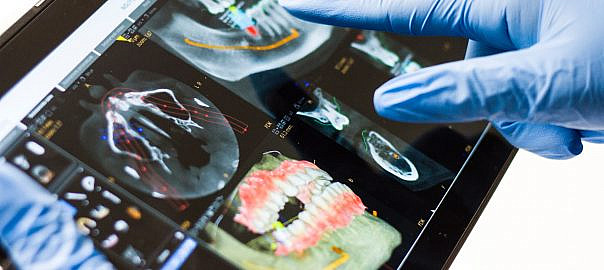When plaque and tartar build up on the teeth, the associated bacteria irritates the gums and causes them to recede, bleed and become sore. This is also known as gum disease, which affects 3 in 4 UK adults.
As gum disease is the leading cause of tooth loss, if you are noticing signs of gum disease in between visits to the dentist, it’s crucial that you book an appointment with your dental hygienist as soon as possible.
Some of the symptoms to look out for include swollen gums, tender gums, receding gums, gaps developing between the teeth, loose teeth, a change in the way teeth fit together when biting, bad breath, bad taste in the mouth and bleeding gums.
When patients with gum disease visit us, the most common question they will ask is “Can gum disease be reversed?”. This guide explains everything you need to know about the types of gum disease and whether or not they can be reversed.
The Types of Gum Disease
Many patients get confused with the different types of gum disease and assume there is just one type. However, gum disease is separated by different stages and can be more complex to treat as it progresses to the next stage. In total, there are four categories of gum disease.
Gingivitis
Gingivitis is a non-destructive form of gum disease where gums appear red, swollen and can bleed easily. At this stage, there are only a few signs at this stage and most are painless, meaning that gum disease can often go unnoticed.
Gingivitis is most commonly caused by a lack of oral hygiene and is reversible. As the mildest form of gum disease, gingivitis must still be treated by seeking professional treatment otherwise it can progress to periodontitis. Gingivitis is the only stage of gum disease that is completely reversible as it has not yet had time to attack the bones. Excellent oral hygiene and regular dental checkups can treat and reverse gingivitis.
Slight Periodontitis
Slight periodontal disease is the second stage of gum disease that spreads below the gum line and can also affect the gum tissue. Some common symptoms of periodontitis include bad breath, receding gums and pockets around the gum line where bacteria hides. At this stage, the infection has already spread to the bone.
It is not reversible, but it is manageable. This does mean that patients will need to visit their dentist for treatment as excellent oral hygiene is not sufficient in reversing the damage thus far.
Moderate Periodontitis
The third stage of periodontal disease, also known as moderate gum disease, cannot be reversed. Unfortunately, the systems are the same as the second stage (slight periodontitis) however, the effects are greater, with bacteria beginning to attack your bloodstream and immune system. While it isn’t completely reversible, it can be controlled and managed with expert medical care and treatment. Treatment can be given in the form of scaling and root planing to deep clean the gums and remove the deposits of bacteria.
If moderate periodontitis is left untreated, it can progress to bone and tooth loss, gum sensitivity and increased bleeding.
Advanced Periodontitis
The fourth and final stage of periodontitis is known as advanced periodontitis and occurs when the infection spreads and evolves into disease-causing bacteria. This, unfortunately, gives you a much higher risk of bone loss. Advanced periodontal disease causes red, swollen gums that ooze pus and can also be paired with the loosening of teeth, cold sensitivity, painful chewing, and severe halitosis.
This stage of periodontitis requires treatment in order to clean the periodontal pockets developed through the stages and rid them of bacteria. If left untreated, advanced periodontitis can lead to gum recession, spacing or gaps between the teeth and serious health problems.
Gum Disease Treatment
Gum disease treatment will depend on the extent of your gum disease and how severe the case is. We do recommend reading our guide to the Ways To Stop Bleeding Gums, however, even if the bleeding does stop, you will still need to visit your dentist.
You cannot cure gum disease, but you can control it as best as possible. The main goal of treatment is to control the infection.
If you do suspect you have gum disease, we advise you to contact us as soon as possible. We also advise that you:
- Brush your teeth at least twice a day and after meals with a fluoride toothpaste
- Floss regularly to remove plaque from between teeth
- Using interdental brushes in between your teeth that are the correct size
- Visiting your dentist/hygienist routinely for a check-up and professional cleaning
- Quit smoking (this can make treatment for gum disease less successful)
- Eat healthy
Book a Dental Hygiene Visit
Treating periodontal disease quickly is extremely important and critical in preventing further damage and serious health issues. The best way to keep on track and reduce the risks of gum disease is to schedule regular check-ups and cleanings, while practicing good oral hygiene on a daily basis.
If you are noticing the signs of gum disease, it’s important to visit your dental hygienist before it’s too late. Dental hygienists are specially trained in the prevention and treatment of gum disease and they can also give you detailed advice on improving your personal oral health regime.
As gum disease can affect other areas of the body including your lungs and your heart, it’s crucial to have regular checkups and that you visit your dentist as soon as you spot the signs of gum disease, even if you only notice one symptom.
We offer a wide range of treatments for gum problems, including advanced oral hygiene care and cleaning, as well as professional restoration treatments such as composite fillings, gum coloured fillings, gum surgery and ongoing hygienist services.
Our dental practice is located in Essex and is easily accessible from most areas around the UK. For more information on our treatments, please get in touch with us or call us on 01708 442 114.




 132a High Street
132a High Street 01708442114
01708442114  care@perfectsmilespa.co.uk
care@perfectsmilespa.co.uk


